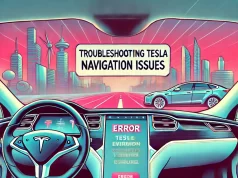Tesla is a leading electric vehicle manufacturer that offers various features and settings to enhance the driving experience of its customers.
One of these features is the stopping mode, which allows the driver to choose how the vehicle behaves when the accelerator pedal is released.
There are three options for the stopping mode: Creep, Roll, and Hold.
#1. Creep mode mimics the behavior of a conventional automatic transmission car, where the vehicle slowly moves forward or backward when the accelerator pedal is not pressed.
This can be useful for parking or driving in traffic.
#2. Roll mode allows the vehicle to coast freely when the accelerator pedal is released, similar to a manual transmission car in neutral.
This can be helpful for maximizing efficiency and range.
#3. Hold mode enables the vehicle to use regenerative braking to slow down and come to a complete stop when the accelerator pedal is released.
This can reduce brake wear and increase battery life. Hold mode also enables one-pedal driving, where the driver can control the speed and braking of the vehicle with just the accelerator pedal.
However, some Tesla owners have reported that their stopping mode option is greyed out and they cannot change it.
This can be frustrating and confusing, especially if they are used to a certain stopping mode. What causes this issue and how can it be resolved?
What are the possible causes of Tesla’s stopping mode greyed out?
There are several possible reasons why the stopping mode option is greyed out on a Tesla:
#1. The vehicle is not in Park mode
The stopping mode can only be changed when the vehicle is in Park mode, not when it is in Drive or Reverse mode.
To change the stopping mode, the driver needs to shift the vehicle to Park mode and then select the desired option from the touchscreen menu.
#2. The battery is fully charged or cold
The regenerative braking system depends on the state of charge and temperature of the battery.
When the battery is fully charged or cold, the regenerative braking power is reduced or limited, which affects the Hold mode functionality.
In this case, the vehicle will automatically switch to Roll mode and grey out the stopping mode option until the battery condition changes.
The driver will see a message on the screen that says “Regenerative Braking Temporarily Reduced” or “Regenerative Braking Temporarily Disabled”.
#3. The traction control system is activated
The traction control system helps prevent wheel slip and loss of control on slippery or uneven surfaces.
When the traction control system is activated, it overrides the regenerative braking system and applies friction brakes to maintain stability.
This also affects the Hold mode functionality and causes the vehicle to switch to Roll mode and grey out the stopping mode option until the traction control system is deactivated.
The driver will see a message on the screen that says “Traction Control Active” or “Traction Control Intervention”.
If none of these reasons apply, then it could be a software glitch or a hardware problem that needs to be fixed by Tesla’s service.
How to troubleshoot the Tesla stopping mode greyed out?
If the driver encounters a Tesla stopping mode greyed-out issue, they can try these 7 ways to troubleshoot it:
1. Check if the vehicle is in Park mode. If not, shift it to Park mode and then try changing the stopping mode option from the touchscreen menu.
2. Check if the battery is fully charged or cold. If yes, drive the vehicle for some time until the battery level drops below 90% or warms up above 10°C.
Then try changing the stopping mode option from the touchscreen menu.
3. Check if the traction control system is activated.
If yes, deactivate it by pressing and holding the traction control button on the touchscreen for 5 seconds. Then try changing the stopping mode option from the touchscreen menu.
4. Reboot the vehicle by holding down both scroll buttons on the steering wheel for 10 seconds until the screen goes black and then wait for it to restart.
Then try changing the stopping mode option from the touchscreen menu.
5. Reset all settings by tapping Controls > Service > Reset All Settings on the touchscreen.
This will restore all settings to their factory defaults, including stopping mode. Then try changing the stopping mode option from the touchscreen menu.
6. Update software by tapping Controls > Software > Check for Updates on the touchscreen.
This will check if there are any software updates available for your vehicle and install them if there are any. Then try changing the stopping mode option from the touchscreen menu.
7. Contact Tesla service by tapping Controls > Service > Schedule Service on the touchscreen.
This will allow you to schedule an appointment with the Tesla service center for diagnosis and repair of your vehicle.
Tesla’s stopping mode feature is designed to give drivers more options and flexibility in how they drive their electric vehicles.
However, sometimes this feature may not work as expected and become greyed out. By understanding what causes this issue and how to troubleshoot it, drivers can enjoy their Tesla’s stopping mode feature without any hassle.




